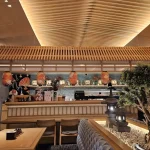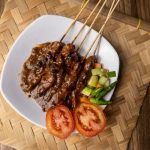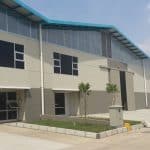Liga Asuransi – Reader friends, how are you? May you, your family and your business always be in good condition, amen. In this blog, we always focus on discussing risk management and insurance for various types of businesses. This time, we will discuss fine dining restaurants, one of the premium culinary businesses that is growing rapidly in Indonesia. With the various operational risks they face, it is important for restaurant owners to understand the best protection that insurance can provide. If this article was interesting, feel free to share it with your colleagues. Also find hundreds of other interesting articles about risk and insurance on this blog!
Imagine a renowned fine dining restaurant in Jakarta that provides a luxurious culinary experience with exclusive dishes such as wagyu steak or lobster bisque. However, unexpected incidents such as damage to premium cooking equipment, electrical short circuits, or customer claims due to food that is not up to standard can occur at any time. This kind of incident can disrupt restaurant operations, even causing significant financial losses.
Fine dining restaurants such as AMUZ Gourmet Resto in Jakarta, The Plantation Grill in Bali, or Mozaic in Ubud are examples of places known for their quality service and premium menus. They offer an extraordinary dining experience with an elegant atmosphere, state-of-the-art cooking equipment and the finest raw materials, including truffles, foie gras and imported meats. However, behind the glitter of this high-end service, there are large and often unrecognized operational risks.
The fine dining restaurant business has unique characteristics, ranging from dependence on modern cooking equipment to the supply of high quality imported raw materials. With high operational costs, financial, legal or asset damage risks become a serious threat if not managed properly.
This article aims to help fine dining restaurant owners understand the various risks they face, the importance of having insurance to protect their business, and how to choose a protection policy with premiums that match the value of the business. With the right protection, your restaurant can continue to provide a premium culinary experience without interruption.
Uniqueness and Challenges of Fine Dining Restaurants
- The Uniqueness of Fine Dining Restaurants
Fine dining restaurants are the pinnacle of premium culinary experiences that combine art, innovation and craftsmanship in serving food. There are several main unique features that make fine dining restaurants different from other types of restaurants:
Exclusive Menu
The dishes offered at fine dining restaurants are usually designed by Michelin-starred chefs or professional chefs with special skills. The menu often features rare and high-quality ingredients such as wagyu beef, lobster, truffles and foie gras. For example, restaurants like Mozaic in Ubud offer a degustation experience with a menu that combines local and international ingredients.
Premium Equipment
Fine dining restaurants rely on high-end cookware to ensure every dish is of the highest quality. Appliances like sous-vide machines, multifunction ovens and premium grills come standard in their kitchens. These tools are designed to provide precision in cooking, but require special care and a large investment.
Service Concept
Service at the fine dining restaurant is of international standard, with high attention to detail. Starting from perfect table settings, sommeliers who are ready to recommend the best wines, to serving food with stunning plating art. This experience is designed to give customers a luxurious and exclusive feel.
- Operational Challenges
Despite its uniqueness, fine dining restaurants face a number of operational challenges that require special attention:
Fire Risk
The use of sophisticated cooking equipment such as grills and ovens with high temperatures increases the risk of fire. Especially if the kitchen is managed by staff who are inexperienced or don’t understand equipment maintenance. An electrical short circuit in premium cooking equipment can also trigger a fire that threatens the safety of employees and restaurant property.
Cooking Equipment Damage
Premium cooking equipment requires regular maintenance to maintain its performance. However, due to intensive use, these tools are at high risk of damage. For example, a broken sous-vide machine can disrupt food preparation processes that require precision cooking techniques. The cost of repairing or replacing this equipment is often very expensive, which can burden restaurant finances.
Customer Claims
Fine dining restaurants serve customers with high expectations of food quality and service. However, problems such as allergies that are not disclosed on the menu or food that is not up to standard can trigger legal claims from customers. For example, if a customer experiences an allergic reaction to an ingredient such as nuts or seafood, the restaurant could face lawsuits that impact the business’ reputation and finances.
Supply Chain Disruptions
The fine dining restaurant relies heavily on high-quality imported raw materials such as wagyu beef, premium cheeses and truffles. Disruptions to the supply chain, such as delivery delays or price increases for imported ingredients, can impact restaurant operations. Additionally, declining quality of raw materials can impact customer experience and restaurant reputation.
Key Risks Threatening Fine Dining Restaurants
- Risk of Fire and Property Damage
Reason:
Fine dining restaurants often use sophisticated cooking equipment such as high-tech ovens, grills with extreme temperatures, or sous-vide machines that require large amounts of electricity. Unfortunately, this equipment poses a potential risk of fire if an electrical short circuit occurs or if it is not used properly. In addition, staff negligence, such as leaving cooking utensils unattended or not turning off equipment after use, can trigger a fire in the kitchen.
Impact:
Fires can cause major losses, including damage to buildings, restaurant interiors, and expensive cooking equipment. For example, damage to a steak grill or premium pizza oven can significantly disrupt restaurant operations. The costs to replace or repair damaged property are very high, not to mention the losses due to lost income during the repair period. Additionally, restaurants may lose loyal customers as confidence in their business declines.
- Legal Risks and Customer Claims
Example:
Fine dining restaurant customers have high expectations for food quality and service. However, issues such as food allergies not stated on the menu or food that is not fresh can trigger legal claims. For example, a customer who is allergic to peanuts might file a lawsuit after consuming a dish that did not include information about peanut content.
Impact:
Customer claims can result in significant financial losses, including legal costs and compensation. Worse yet, these kinds of claims can damage a restaurant’s reputation and make customers lose trust. In the fine dining business, reputation is everything; one bad review on social media or a review portal can have a big impact on business continuity.
- Financial Risk
Loss of Income:
Fine dining restaurants rely heavily on daily operations to generate revenue. If a restaurant has to close temporarily due to a disaster such as fire or flood, income can stop while expenses continue. For example, staff salaries, space rental and other operational costs must still be paid even though the restaurant is not operating.
Big Costs of Replacing Premium Cookware:
Premium cooking equipment such as multifunction ovens, sous-vide machines, or steak grills are not only expensive to purchase but also expensive to repair or replace. Damage to these tools can disrupt restaurant operations and require large investments to restore normal kitchen function.
The Right Type of Insurance for Fine Dining Restaurants
Fine dining restaurants are a type of culinary business with very high operational standards. From luxurious interior design to premium cooking equipment, everything is designed to provide the best experience to customers. However, the risks faced by this restaurant are no less big. The following are the types of insurance that are relevant to protect fine dining restaurants:
Benefit:
Property insurance provides protection against physical damage to buildings, cooking equipment and restaurant interiors due to fire, flood, earthquake or other disasters. In the fine dining business, restaurant buildings are often equipped with luxurious decorations, premium cooking equipment and expensive raw materials whose value is very high.
Example:
A fine dining restaurant that uses a high-end oven to grill steaks experienced a fire due to an electrical short circuit. The losses incurred included damage to the kitchen, building and premium cooking equipment. With property insurance, repair costs can be covered, so the restaurant can restore its operations without burdening finances.
Benefit:
Public liability insurance protects restaurants from legal claims brought by customers due to injury or food poisoning. In fine dining, customer expectations are very high, so any mistake, whether small or large, can result in lawsuits.
Example:
A customer experienced an allergic reaction after eating food that did not include specific allergy information on the menu. Customers submit claims for the health losses they experience. With public liability insurance, restaurants can cover compensation and legal costs without disrupting business operations.
Benefit:
This insurance is designed to replace lost income if the restaurant has to close temporarily due to disaster or damage. In the fine dining industry, even a few days of lost revenue can have a big impact, especially with high operational costs such as staff salaries, space rental and raw material purchases.
Example:
Fine dining restaurants in Jakarta had to close for a month due to renovations after the fire. Even though restaurants are not operating, they still have to pay staff salaries and other operational costs. With business interruption insurance, restaurants can continue to meet their financial obligations without having to dip into reserve funds.
- Product Insurance
Benefit:
Product insurance provides protection against legal claims resulting from defective or unsafe food or drinks. These risks include contaminated food, raw materials that are not fresh, or drinks served that do not meet standards.
Example:
A customer filed a lawsuit after consuming a seafood dish that caused food poisoning. Product insurance helps restaurants cover legal fees, customer compensation, and even the costs of dealing with a reputation crisis.
- Premium Restaurant Special Insurance
Benefit:
Fine dining restaurants have unique needs that none of the types have
Estimated Cost of Fine Dining Restaurant Insurance Premiums
Fine dining restaurants need insurance protection that suits the risks and assets they own. The cost of insurance premiums is determined by various factors, ranging from the value of the asset to the scope of the risk being protected. The following is a breakdown of the factors that influence premiums, the range of premium costs based on restaurant size, and how to adjust premiums to your budget.
- Factors Affecting Insurance Premiums
Restaurant Asset Value
Fine dining restaurants generally have high asset values, including buildings with premium interior designs, sophisticated cooking equipment such as multifunction ovens or sous-vide machines, and expensive raw materials such as truffles or wagyu beef. The higher the asset value, the greater the risk that insurance must cover, so the premium is also higher.
Restaurant Location
The location of the restaurant greatly influences the risks faced. Restaurants located in areas prone to disasters such as floods or earthquakes will have higher premiums because the risk of property damage is greater. For example, restaurants in the Jakarta area that frequently experience flooding will need additional protection.
Types of Risk Covered
Fine dining restaurants need comprehensive protection that covers the risk of fire, damage to premium cooking equipment, legal claims from customers, and operational disruption. The more coverage you want, the premium you have to pay also increases.
- Insurance Premium Cost Range
The cost of fine dining restaurant insurance premiums varies greatly depending on the size of the business and coverage needs. The following is a range of estimated premium costs based on restaurant size:
Small Restaurant:
Restaurants with an asset value of under IDR 1 billion, such as small fine dining restaurants with limited capacity, usually have an annual premium of between IDR 10 million to IDR 20 million.
Mid-Range Restaurants:
Restaurants with an asset value of between IDR 1 billion and IDR 5 billion, such as a steakhouse or bistro with a strategic location, have an annual premium of between IDR 30 million and IDR 50 million.
Great Restaurants:
Restaurants with assets above IDR 5 billion, such as luxury fine dining restaurants with complete facilities and high-quality imported raw materials, have annual premiums starting from IDR 100 million and above.
- How to Adjust Premiums to Budget
Choose Insurance Coverage that Suits Your Needs
Restaurant owners can arrange insurance coverage according to the priority risks they face. For example, restaurants located in fire-prone areas may prioritize protection for fire and property damage.
Consult an Insurance Broker
A licensed insurance broker can help you get an insurance package that fits your budget without sacrificing the protection you need. Brokers can also negotiate lower premiums with insurance companies.
Evaluate Asset Values Periodically
Make sure the value of restaurant assets, including buildings, cooking equipment and raw materials, is up to date so you don’t pay a premium for assets whose value has decreased.
Information Required for Issuance of an Insurance Policy
So that the issuance of an insurance policy for a fine dining restaurant can run smoothly, there is some important information that must be prepared by the business owner. This information helps insurance companies understand the risks they face and determine appropriate coverage and premium costs.
- Business Profile
The business profile provides a general description of the restaurant that will be insured. This information includes:
- Restaurant Description: Describe the restaurant concept, whether it is fine dining, casual dining, or a particular specialty such as a steakhouse or Italian restaurant.
- Restaurant Location: The complete address of the restaurant, including whether it is in the city center, tourist area, or a disaster-prone location such as a flood-prone area.
- Number of Employees: The total number of staff working, from chefs, waiters, to management staff.
- Concept and Services: Information about additional services such as wine pairing, live cooking, or private dining.
- Asset Value
Insurance companies require a detailed assessment of restaurant assets to determine the amount of coverage needed. This includes:
- Building: The value of the restaurant property, whether owned or rented, including any renovations or luxury interior design.
- Premium Cooking Equipment: Espresso machines, multifunction ovens, sous-vide appliances and other equipment.
- Interior and Decoration: Dining table, premium chairs, luxury tableware and decoration elements.
- Raw Material Stock: The value of available raw materials, especially imported ingredients such as wagyu beef, premium cheeses and truffles.
- Claim History
- Claims history data helps insurance companies assess risk based on previous events. This information includes:
- Previous Claims: Number of claims filed in the past year, type of claim (fire, food poisoning, equipment failure), and how the claim was resolved.
- Preventive Measures: Steps that have been taken to prevent a similar incident, such as staff training or improving security systems.
- Key Risks
Identification of specific risks is critical to tailoring insurance coverage. Risks that need to be explained include:
- Disaster Prone Location: Is the restaurant located in an area frequently affected by floods, earthquakes or fires.
- Dependence on Imported Materials: How dependent on imported raw materials can be influence restaurant operations if supply chain disruption occurs.
Why is it necessary to use official insurance broker services from OJK?
Managing a fine dining restaurant that has premium assets and a high reputation requires proper insurance protection. However, finding a suitable policy can be a challenge, especially due to the complexity of the needs of a premium culinary business. This is where the role of an official insurance broker becomes very important. Here are the reasons why using the services of an authorized insurance broker is the best step to protect your restaurant.
- Specific Skills
Insurance brokers have a deep understanding of the unique needs of premium restaurants such as fine dining. They understand specific risks, such as damage to premium cooking equipment, disruption of the supply of imported ingredients, and legal claims from customers. With their experience and expertise, brokers can recommend insurance products that best suit the risks your business faces.
- Access to the Best Insurance Products
Insurance brokers have access to various well-known insurance companies, so they can offer a wide selection of insurance products. This allows restaurant owners to choose coverage that fits their budget and needs. Additionally, brokers can also offer insurance packages designed specifically for premium restaurants, including additional coverage for high-end cooking equipment and imported raw materials.
- Premium Negotiation
One of the advantages of using a broker is their ability to negotiate more affordable premiums without reducing coverage coverage. By understanding your business risk profile, a broker can ensure that you only pay for the protection you really need, keeping insurance costs efficient.
- Claim Assistance
Handling an insurance claim can be a complicated and time-consuming process. Insurance brokers act as companions in the claims process, ensuring that all required documents are complete and claims are processed quickly and efficiently. With broker support, you can focus on restaurant operations without having to worry about claims administration challenges.
Conclusion
Managing a fine dining restaurant is not just about providing a premium culinary experience, but also protecting your business from major risks. From kitchen fires, damage to high-end cooking equipment, to customer claims, these risks can have a significant impact on the sustainability of your restaurant. With high asset values and strict service standards, insurance protection is an absolute necessity to maintain the stability and reputation of your business.
Insurance for fine dining restaurants offers comprehensive coverage, from property insurance to protect premises and cooking equipment, to public liability insurance to handle customer claims. In fact, with business interruption insurance, your income remains guaranteed even if the restaurant has to close temporarily due to a disaster.
However, choosing the right insurance can be a challenge. This is where the role of an insurance broker like L&G Insurance Broker becomes very important. With expertise and access to various insurance companies, we are ready to help you get the best protection with efficient premiums.
“Protect your fine dining restaurant with the appropriate insurance! Contact L&G Insurance Brokers for a free consultation and find the best protection solution. Don’t wait until risks arise—contact us now and ensure your premium business stays safe and thrives!”
Don’t compromise the future of your business. Trust your protection to professionals who understand your needs. Contact us today!
Looking for insurance products? Don’t waste your time and contact us now
HOTLINE L&G 24 JAM: 0811-8507-773 (CALL – WHATSAPP – SMS)
Website: lngrisk.co.id
Email: oktoyar.meli@lngrisk.co.id
—















